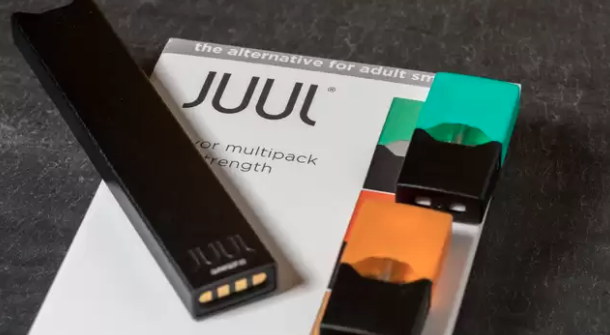The Juuling Epidemic
Millions of teenagers in America have become swept up in the new culture of Juuling. A Juul is a type of E-cigarette that was created in 2015 with the intention of helping adult smokers quit cigarettes. But what started as a means of helping adults quit cigarettes quickly turned into an independent smoking aid used by ex-smokers and smokers alike. For instance, teenagers across the country have begun using Juuls en masse. Juuling has become such a widespread issue that it has begun to grasp the attention of several high school administrators, all of whom are deeply concerned for the well beings of their students.
Nowadays, one could argue that every high school student knows at least one fellow student who owns a Juul. And what’s worse is that many teens do not believe “Juuling” is harmful to their bodies. It has become a popular belief in schools that the harmful, long term effects of Juuling are negligible as long as it is done in moderation. And since there is not sufficient scientific evidence regarding the short and long term effects of Juuling, many children simply disregard the (high) possibility that Juul can be detrimental to one’s health. One anonymous student stated that he or she is not deterred by Juul because no concrete evidence exists against its usage. The student said, “We know there are negative effects, but until we actually see people dying it’s not as concerning as cigarettes.”
There is a common misconception that Juuling should be condoned because a Juul is safer than other illicit substances like alcohol or marijuana. This, however, is far from the truth. Juul is not safe by any metric. In fact, one Juul pod contains about the same amount of nicotine as a whole pack of cigarettes. The inhalation of nicotine, although less toxic in a Juul than in a cigarette, is highly addictive and is proven to be harmful to brain development in teens.
Juul has also been proven to be an effective “gateway drug.” According to the National Institute on Drug Abuse, 31% of E-cigarette users will start smoking combustible smoking products like cigarettes and cigars within six months of smoking their first E-cigarette. What’s even more concerning is the fact that E-cigarettes often contain harmful additive chemicals. The NIDA stated that 66% of teens wrongfully believe their E-cigarettes only contain “flavoring.” Teens are ignorant of the fact that their E-cigarettes also contain nicotine, aldehydes, and toxic metals. Indeed, teens are hardly aware of what they are putting into their bodies, and their ignorance will almost certainly have dire consequences in the future.
Why is it then that so many teenagers choose to Juul? One major appeal of the Juul lies in its size. Juuls can be easily hidden due to their small size. It is also very difficult to detect when a Juul has been used because the device does not leave behind a scent or trace. All of these factors make it incredibly easy for a student to leave class, go to the bathroom, and Juul without anyone knowing. One anonymous student stated, “Juuling has become a big interference in my school work. It demands that I leave in the middle of class instead of focusing on my work.”
Many teenagers are also drawn to Juul because of peer pressure. High schoolers are eager to fit in with their peers. Students are prone to chase the thrill that one typically receives after doing something illegal or in violation of their school’s rules.. Rabbi Albo explained, “[Juul] is one of those things where kids are drawn to it because it is illegal and makes them feel more like an adult, like they’re someone older. Unfortunately, kids don’t always have the ability to recognize the value of the different stages of their lives at the right time.”
This outburst of the “‘Juuling epidemic’ can be attributed to many different factors. Many students feel that Juul has gotten so much attention because of social media. One anonymous student said, “People posted about Juul on social media, so it became a “trend,” just like anything else. Just like social media can destroy a person’s self esteem it can also encourage a person to feel that he or she must begin vaping in order to fit into the culture.” Another student explained that Juul’s success can be attributed to the quality of the product itself. The student said, “You can hide it easily and the flavors are appealing.” One upperclassman noted that Juul has become much more present in his or her life as he or she has progressed through high school. The student said, “As I progress through high school, more kids have begun vaping. As a senior, I’ve been exposed to this culture more and more.”
Students have expressed mixed feelings about the rise in Juuling amongst teens. One student remarked, “Juul is bad for your body, but then again it makes your body feel good. It’s difficult to say whether it’s really only good or bad.” Another student stated, “I have found myself on multiple occasions being pressured by my friends to abandon my beliefs and give in to peer pressure by Juuling.” Indeed, as Juuling becomes more common, many parents have begun to fear for their children’s safety. Ramaz gym teacher Ms. Cohen said, “As a parent of two teenagers, it really scares me because kids think [Juul] is ‘safer.’It is even more accessible than traditional cigarettes – kids can hide it in so many places that we can’t even catch them. Kids think it’s cool, but it’s not.”
In cooperation with other yeshivot, Ramaz has begun to tackle the Juuling epidemic in a more effective way under the bannister of a new alliance. The Yeshiva League Substance Use Initiative was created by a multitude of yeshivot with the goal of preventing substance use and abuse. On January 30th, Head of the Upper School Rabbi Stochel and Director of Guidance Dr. Zeitchik sent out an email to all Upper School parents explaining the trajectory of this new initiative. The YLSUI’s first step is to gather anonymous data via a comprehensive survey that will begin at the end of February. As the email explained, “The survey will be completely anonymous in order to gather accurate information about the scope of substance use and to develop a data-based community profile.” The YLSUI then plans to use a public health model to alter teenager’s fixation on harmful and illicit behavior. A public health model relies on classroom education and deterrence strategies, focusing primarily on identifying risk factors and developing preventive strategies to shift the subject’s behaviors.
The creation of the YLSUI shows that Ramaz and the larger Jewish tri-state area have begun to recognize the fact that many students are affected by Juul, alcohol, and drugs. Now it is up to our community as a whole to solve the problem. A solution will require everyone’s cooperation, especially students. High school students must be willing to learn from their mistakes, and parents and faculty must to be prepared to inform the students of their wrongdoings. Together as a community, hopefully we can continue to prevent Juuling from becoming a bigger epidemic than it already is.



